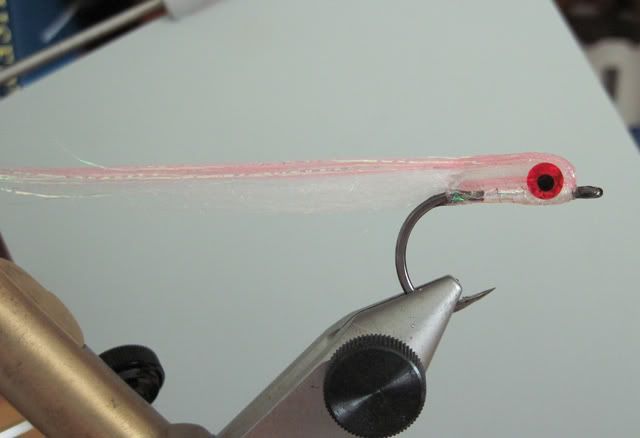This is a Sequence for a fly called a Polar Candy, it's a variation on the surf candy, which the Australians prefer for Tuna fishing.
You can tie them with Pink, Chartreuse, Olive or Grey backs.
I have spent many attempts trying to simplify the dressing and speed up the tying but i'm afraid the only the way to get the flies to look right and work properly is to employ some patience, as you will see from the sequence.
so ingredients are as follows.
Hook: Varivas 2600st-v size 1 or Size 2/0, the dressing in the sequence is on a size 1.
Thread: flat white for underbody, fine clear mono for the over body.
Underbody: Flat silver lurex.
Overbody: Mini pearl mylar.
Underwing: White Polar fibres.
Overwing: DNA holofusion, in this case Pink.
Eyes: 3/16ths flat red prism eyes (use 1/4 for the 2/0)
Epoxy: i prefer Z-Poxy 5 minute, but some of the UV cure stuff would probably work even better.
Step 1: Put the vice in the hook.

Step 2: Start winding on the white thread.

Step3: Tie in the flat silver lurex about level with the hook point and take thread back up to the eye.

Step 4: Wind lurex up in slightly overlapping turns and tie down.

Step 5: Whip finish and trim ends.

Step 6: Cut a piece of Mylar tubing to the right length, just slightly longer than the lurex body.

Step 7: Slide Mylar over the underbody.

Step 8: Using the mono thread , wind down over the mylar to the end and then back to the eye, tying it down fully.

Step 9: Select some Holofusion and tease out the ends so they have a tapered affect.

Step 10: Tie in the holofusion with the longer part forward over the eye approx 3 hook lengths. Tie down with 3 turns of thread.

Step 11: Next select some polar fibers, a decent sized bunch as per the picture, approx 1 thumb width at the base.

Step 12: Remove the under fluff by stroking the butt ends with your fingers (you could use a small comb, but i prefer the fingers) And discard the fluff.

Step 13: Tie in the polar fibers as tight as possible to the butt, as shown, with the fibers extending over the eye of the fly.
Gentle pull the holofusion so it is slightly longer than the polar fibers.

Step 14: Whip finish the mono, under the fibers and trim the tail of the holofusion to the length of the underbody.

Step 15: Mix up a small amount of epoxy.

Step 16: Apply the mixed epoxy to the underside of the fly covering the whole mylar portion.

Step 17: Apply some more epoxy to the top side of the fly working it into the butt ends of the holofusion and polar fibers.

Step 18: Finally apply some epoxy to the holofusion and polar fibers for about the length of the body. Do this to both sides.

Step 19: Now for the patient part, hold the fibers back, making sure they stay one on top of the other, and that the polar fibers spread out a little to give the fly some body. You will have to hold the fly like this for about 3-4 minutes.

Step 20: After 3-4 mins, the body should stay the shape you have held it in. make sure it is straight on the hook at this point as it is still pliable.

Step 21: Stick eyes on while epoxy is still tacky, one on either side


Step 22: Check profile from above, it should look like this.

Step 23: Mix up another smallish quantity of epoxy.

Step 24: Apply the epoxy to both sides of the fly working it back to the bend of the hook. Make sure it covers the eyes and gets into the polar fiber just at the bend.

Step 25: Remove the hook from the vice and turn it by hand to ensure a the epoxy flows into the desired shape.



Step 26: once happy with the shape, put the fly in a fly turner for 10mins, to cure properly.

Step 27: Once it is cured the profile of the head should be like this, hopefully with as few bubbles as possible


it should be lozenge shaped when viewed from above, like this.

The finished fly in full profile, showing the correct proportions. I'm sure it would have its uses back in the UK too.

Have fun giving it a go

Cheers
Sandy

